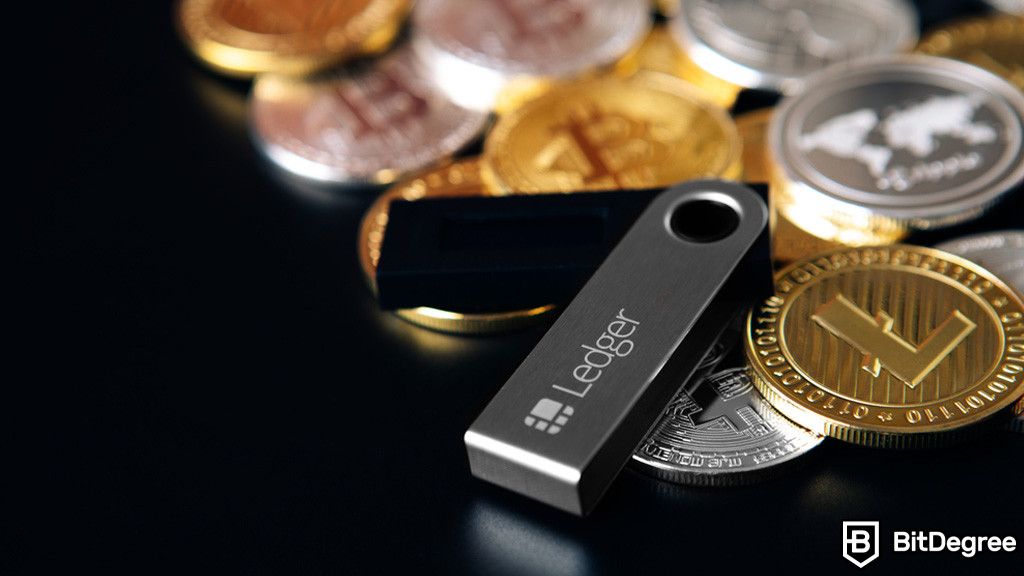Key Takeaways
- A Web3 wallet is vital for blockchain activities like exchanging tokens and accessing dApps.
- There are two main types of crypto wallets: hot wallets and cold wallets; each has its unique characteristics and benefits.
- Crypto wallet owners should implement all the necessary security measures to protect their assets.
Stop overpaying - start transferring money with Ogvio. Sign up, invite friends & grab Rewards now! 🎁
If you're just getting started with blockchain technology and managing digital currencies, you must be curious about how to get a crypto wallet. A crypto wallet is like a digital keychain that holds your cryptocurrencies, playing a crucial role in keeping your digital assets safe and accessible.
Understanding how to open a crypto wallet and manage it properly can get you ahead in this highly dynamic environment. That’s why in this article, we will examine the concept of crypto wallets closely by learning the different types of wallets, how to set up a crypto wallet, and the best practices to keep your assets secure.
After you learn how to get a crypto wallet, I recommend you check out Ledger Nano X, Binance Wallet, Coinbase Wallet, and Zengo. They are the best in the market and great choices for a reliable and secure crypto wallet. That being said, let’s get started.

Did you know?
Subscribe - We publish new crypto explainer videos every week!
How to Store NFTs in 2023 (3 Most Secure Ways Explained)


Table of Contents
- 1. How to Get a Crypto Wallet
- 1.1. What is a Hot Wallet?
- 1.2. How to Get Hot Wallets
- 1.3. What Is a Cold Wallet?
- 1.4. How to Set Up Cold Wallets
- 1.5. Getting a Bitcoin Wallet
- 2. What is a Crypto Wallet?
- 2.1. Definition and Purpose of a Crypto Wallet
- 2.2. How Crypto Wallets Work
- 2.3. Benefits of Using a Crypto Wallet
- 3. Securing Your Crypto Wallet
- 3.1. Advanced Security Measures
- 3.2. Recovery Strategies
- 4. Conclusion
How to Get a Crypto Wallet
So, we understand the importance of having a crypto wallet for managing digital currencies. As we explore how to get a crypto wallet, it's important to know there are two primary types: hot and cold wallets. We'll dive deeper into the unique features and advantages of each, guiding you to make an informed choice that best suits your crypto activities.
Latest Ledger Flex Coupon Found:What is a Hot Wallet?
A hot wallet is like a digital wallet you carry on your internet-connected devices, such as your phone or computer. It's called a "hot" wallet because it's connected to the internet, much like something being "hot" to the touch implies it's actively on or engaged.
The great thing about a hot wallet is its convenience. You can access your digital cash or make transactions pretty much anytime, anywhere, as long as you're connected to the internet. This makes it a fantastic option for those scratching their heads about how to get a crypto wallet without much fuss.
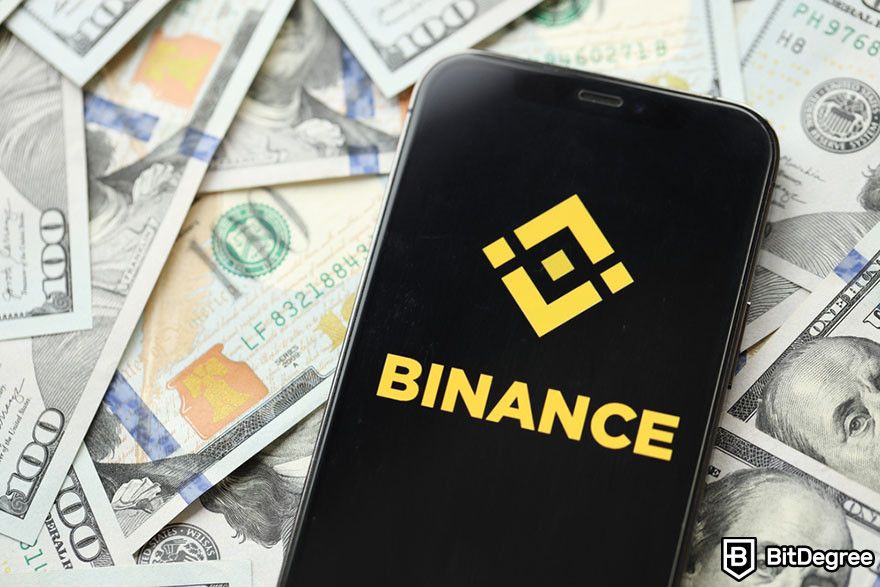
However, there's a flip side. Since it's always online, it's kinda like leaving your house door unlocked. There's a higher risk of unwanted visitors, meaning hackers might find it easier to sneak in and steal your digital coins. That's the trade-off: awesome convenience at a bit of a risk. So, while it's great for everyday use, you might not want to keep all your digital treasure in it, just in case.
Sub-Types of Hot Wallets
There are several sub-types of hot wallets, each with its unique features. Understanding these can help you figure out how to get a crypto wallet that suits your needs:
- Desktop Wallets: These are installed on your computer. Desktop wallets give you full control over your wallet and often include additional cryptocurrency management features. However, they're only as secure as your computer is from viruses and hacks.
- Mobile Wallets: These wallets live on your smartphone. They're super handy for making transactions on the go, like paying for coffee with Bitcoin. The convenience is great, but remember, losing your phone could mean losing your wallet if you're not backed up.
- Web Wallets: Accessed through your web browser, these don't require you to download anything. They're the easiest when you're figuring out how to get a crypto wallet because you can use them from any device with the internet. Just keep in mind, that you're trusting the website to keep your crypto safe.
How to Get Hot Wallets
Now that we know what a hot wallet is and its different sub-types, it is time to get one for your crypto assets. In this tutorial, I will show you the steps to set up two of the most popular and trusted hot wallets in the market: Binance Web3 Wallet and Coinbase Wallet.
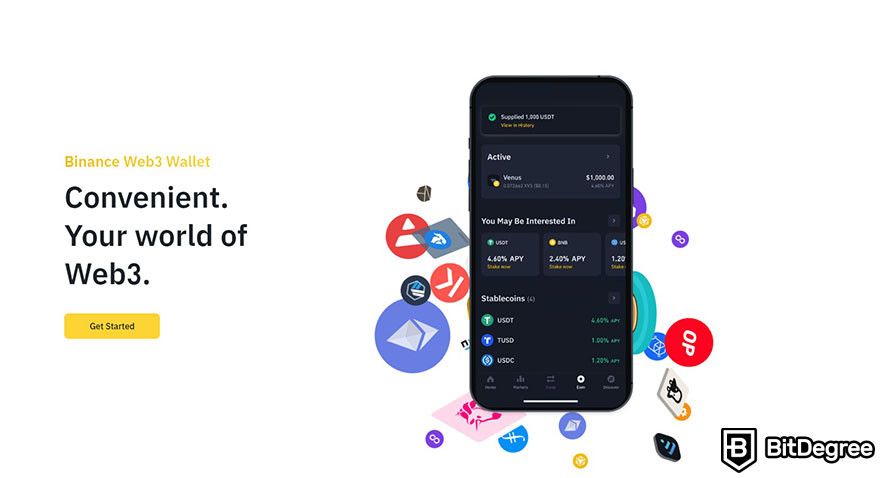
How to Set up Binance Web3 Wallet
Binance Web3 Wallet is a part of the Binance App, meaning that you can access all your crypto and Web3 needs from one place easily. This wallet also lets you access dApps and swap tokens across different blockchains hassle-free.
Binance Web3 Wallet uses Multi-Party Computation technology to secure your assets. It is also a self-custody wallet, meaning that you have complete control of your assets. You can set up this software wallet in a few simple steps, here is how:
Step 1: Download the Binance App on your preferred device. It is available for both mobile and desktop.
Step 2: Create your Binance account if you haven’t already, and complete all the registration and verification steps. Check out our article to learn how to use Binance.
Step 3: Open the app and tap the Binance logo at the top left corner.
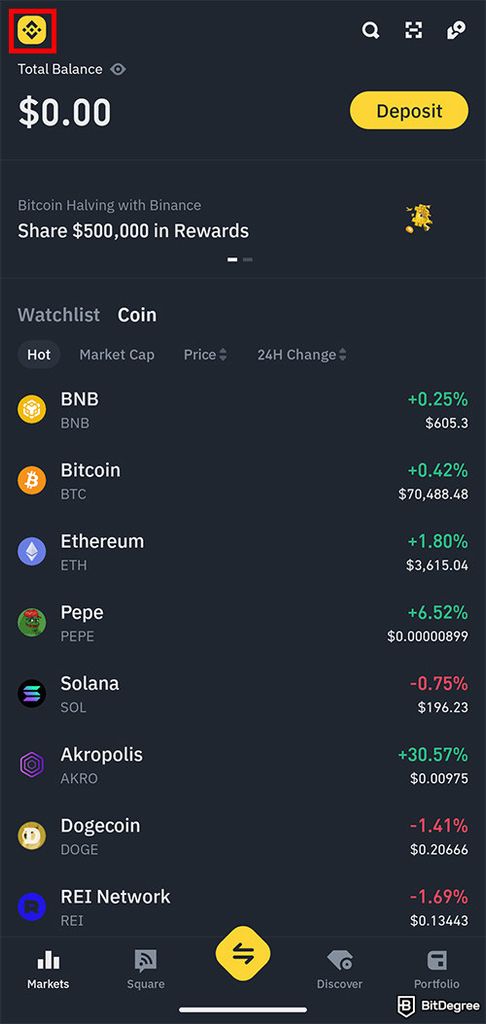
Step 4: Choose "Web3 Wallet".

Step 5: Here, click on "Create Wallet". Wait a couple of seconds until the process is complete.

Step 6: Once completed, you will see the wallet’s interface and a dialog box asking you to back up your wallet.
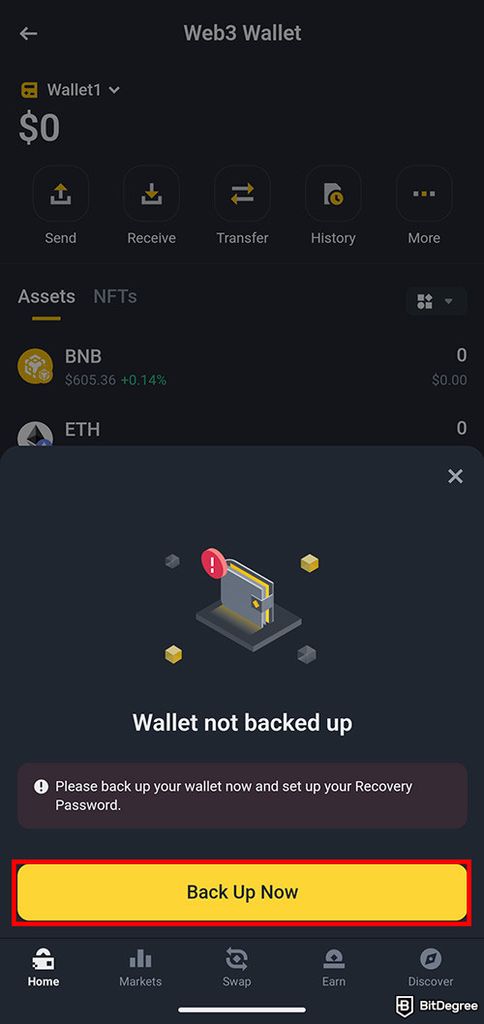
Step 7: Tap the "Back Up Now" button and choose the backup method you want to use. Binance Wallet will give you options to back up using iCloud, Google Drive, or a QR code. All options let you restore access to your wallet from another device.
Step 8: Enter a secret recovery password. Make sure it is unique and easy to remember.
Step 9: Hit "Continue" and confirm that you understand the terms and conditions. Once you’re done, Binance will send your key-shares to your preferred backup method.
Step 10: Make sure to verify your wallet backup. If you do it correctly it should look like the image below.
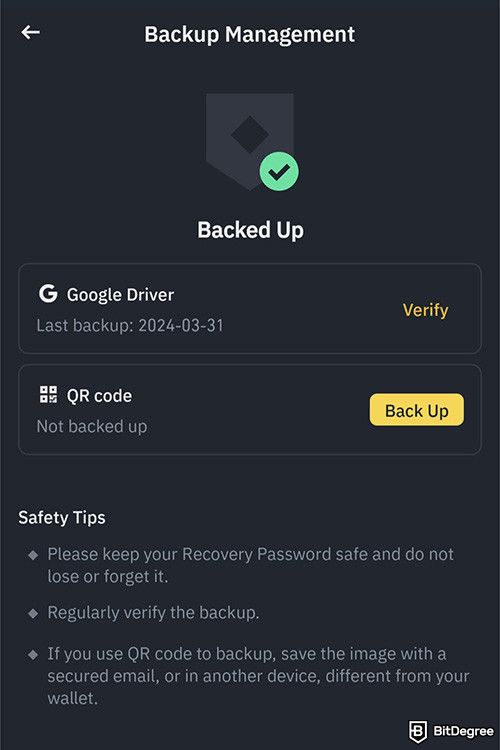
And that’s how to set up a crypto wallet from Binance. Keep in mind that to access the wallet, you must input at least two out of three key-shares generated by the app. So I recommend writing down the key-shares on a piece of paper in addition to the digital backup method.
How to Set up Coinbase Wallet
Another popular option for a hot wallet is Coinbase Wallet. It is a mobile wallet created by Coinbase, which is a perfect option if you want your crypto wallet to be easily accessible from your phone. But you can also access it on your desktop device using the browser extension.
Coinbase Wallet is self-custody, meaning the private keys are stored locally on your device and you are responsible for keeping them safe. Here is how to set up a crypto wallet from Coinbase:
Step 1: Download the Coinbase Wallet mobile app. It is available in the App Store for iPhone or the Google Play Store for Android.
Step 2: Open the app and tap on "Create new wallet". You will be prompted to create a log in password. Alternatively, you can log in using your biometrics like fingerprint or facial recognition.

Step 3: You can claim a free username for your new crypto wallet. This username will let other Coinbase Wallet users identify your wallet address more easily. Pick your username carefully since you can only change it once a year.

Step 4: Once you get access to the wallet’s interface, go to "Settings" > "Security".
Step 5: Under "Backups", choose your new wallet. This is where you can get your recovery phrase, so get your pen and paper ready and make sure you are in a private and secure environment.
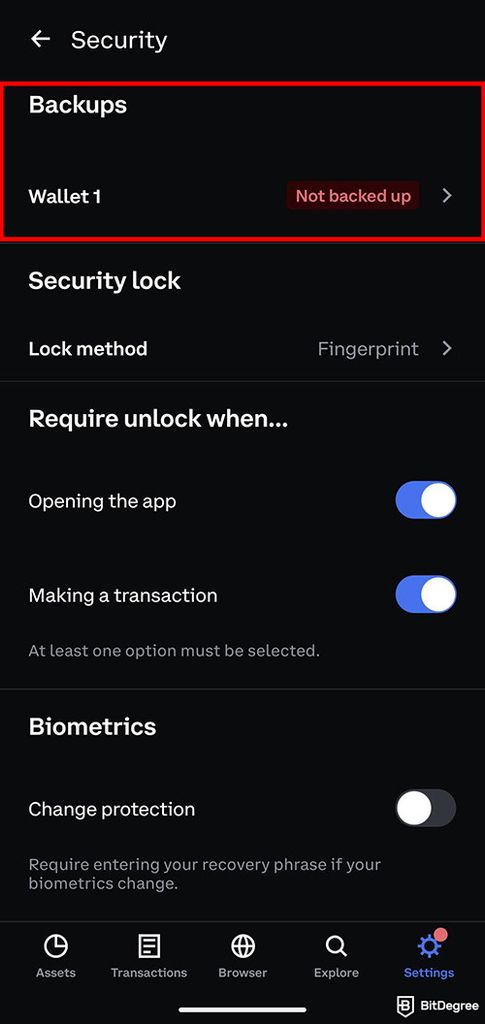
Step 6: Tap "Allow" when a new dialog popup appears, and you will be directed to a new screen. Here, you will see a box with blurred text in it. This is your wallet’s recovery phrase.
Step 7: Tap on the eye icon to reveal the phrase and write it down. Make sure the spelling and word order are correct.
Step 8: Once you are sure that you’ve written the phrase correctly, tap on "Back up manually" and confirm that you’ve saved all 12 words. Tap on "Complete backup".
What Is a Cold Wallet?
Unlike the hot wallet, a cold wallet is not connected to the internet. That's why it's called "cold" – because it's offline, kind of like putting your cash in a freezer for safekeeping. If you're wondering how to get a crypto wallet that's super secure, a cold wallet might be what you're after.
So, what's it for? It's mainly for storing your cryptocurrencies safely away from hackers. Since it's not online, you have a far smaller chance of getting exposed to hackers who may try to steal your assets using internet-based methods like phishing or malware attacks.
The big plus of a cold wallet is its security. It's a solid choice for keeping large amounts of crypto safe over time. But, it's not as convenient as its "hot" counterparts for daily use. Imagine having to open a safe every time you wanted to buy a coffee. That's the trade-off.

For folks figuring out how to get a crypto wallet that balances security with convenience, remember: cold wallets are your digital Fort Knox. Great for long-term storage, but maybe not for your daily spending spree.
Sub-Types of Cold Wallets
Just like hot wallets, cold wallets also have different sub-types, each offering unique ways to keep your crypto secure. If you're diving into how to create a crypto wallet for maximum security, here are the two main options you have:
- Hardware Wallets: These are physical devices, almost like USB sticks, that store your cryptocurrency offline. Hardware wallets are great because you can plug them into a computer, make your transaction, and then safely store them away again. They combine high security with a bit of convenience.
- Paper Wallets: Imagine printing your private and public keys on a piece of paper. That's a paper wallet. Super secure, since it's completely offline, but you have to be careful not to lose it or let it get damaged.
Each type of cold wallet serves the purpose of keeping your digital assets safe from online threats. Hardware wallets offer a blend of security and ease of use, while paper wallets are about as low-tech as you can get, which minimizes their exposure to digital risks. Choosing the right type depends on your needs for security versus convenience.
How to Set Up Cold Wallets
After learning more about cold wallets, it is safe to say that every crypto investor needs to have one to keep their assets away from cyber attacks. That’s why we are going to learn how to get one. In this section, I will show you the process of setting up a Nano X.

The Nano X is the most popular hardware wallet from Ledger. It comes with a CC EAL5+ certified secure chip that will help protect your assets with the highest level of security. Because of these robust security protocols, the process of setting up a hardware wallet like Nano X is also a bit longer compared to its software-based counterparts.
But no need to worry because I’m going to guide you through it. Here are the detailed steps of how to set up a crypto wallet from Ledger:
Step 1: Buy your Nano X from the official Ledger website.
Step 2: Download the Ledger Live app on your computer or phone.
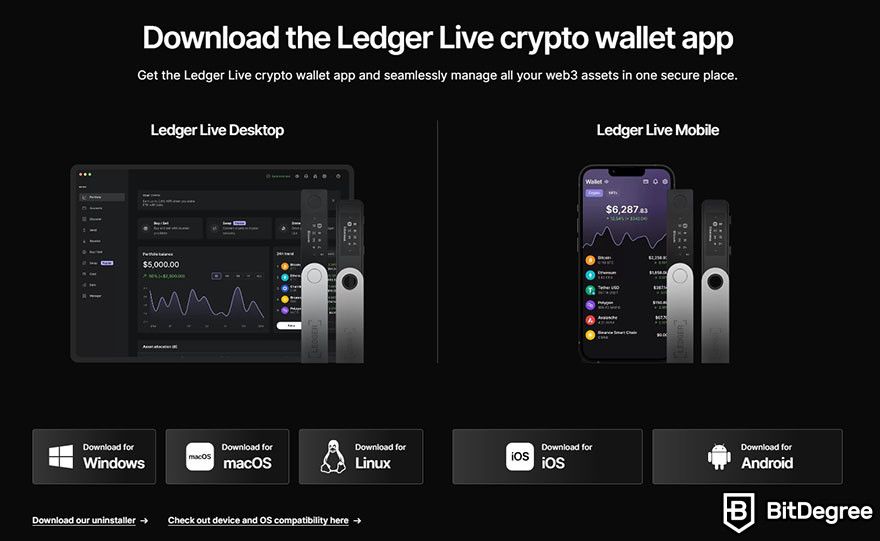
Step 3: Open the app, agree to the Terms of Service and Privacy Policy, then pick "Nano X" and then "Set up a new Nano X."
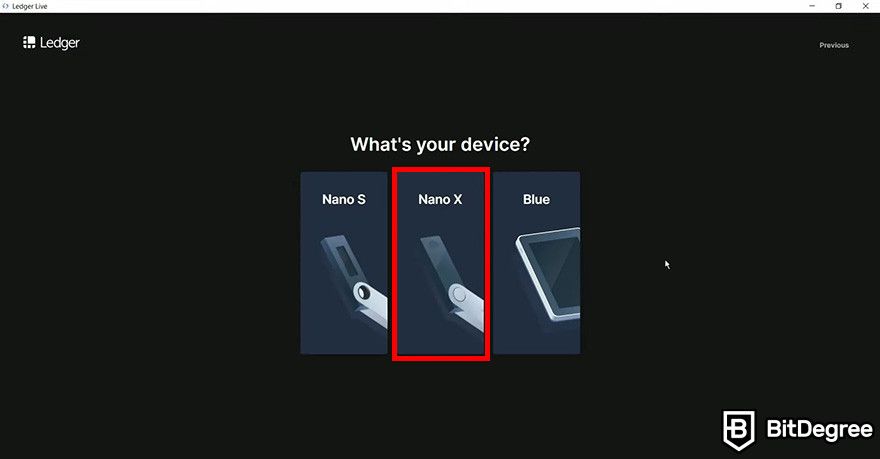
Step 4: Look at the slides the app shows you. Make sure you have a pen and are somewhere private.
Step 5: Connect your Nano X to your device with the USB cable. Follow the instructions on its screen to turn it on.
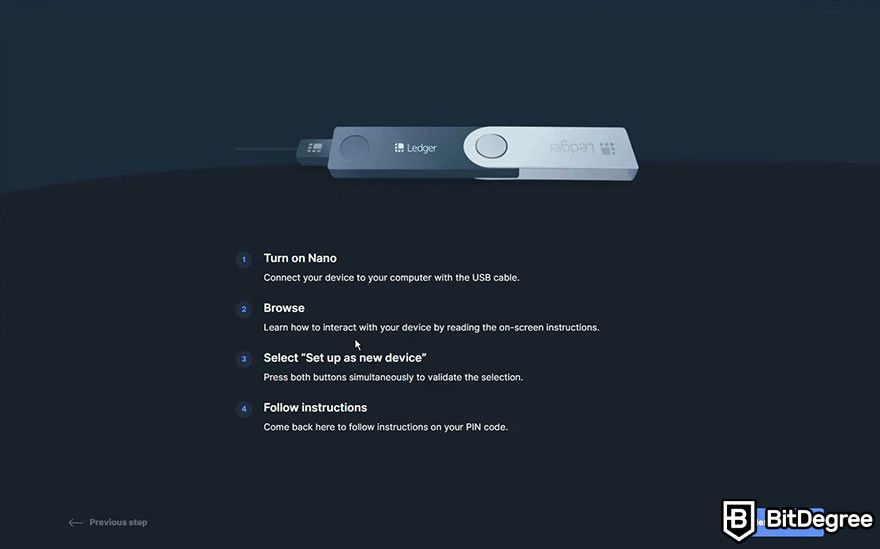
Step 6: Use the buttons on the Nano X to find "Set up as new device" and press both buttons together to choose it.
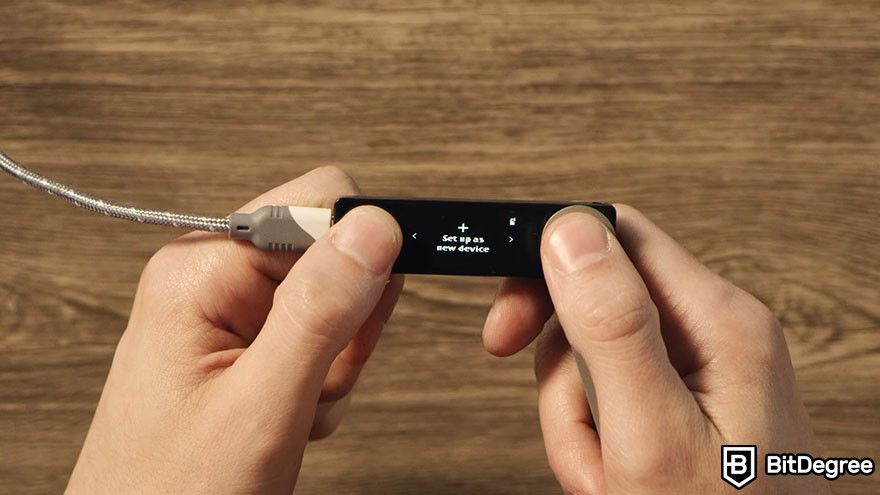
Source: Ledger YouTube channel.
Step 7: Create a PIN by pressing both buttons, then pick your numbers. It’s best to use all eight digits for extra safety.
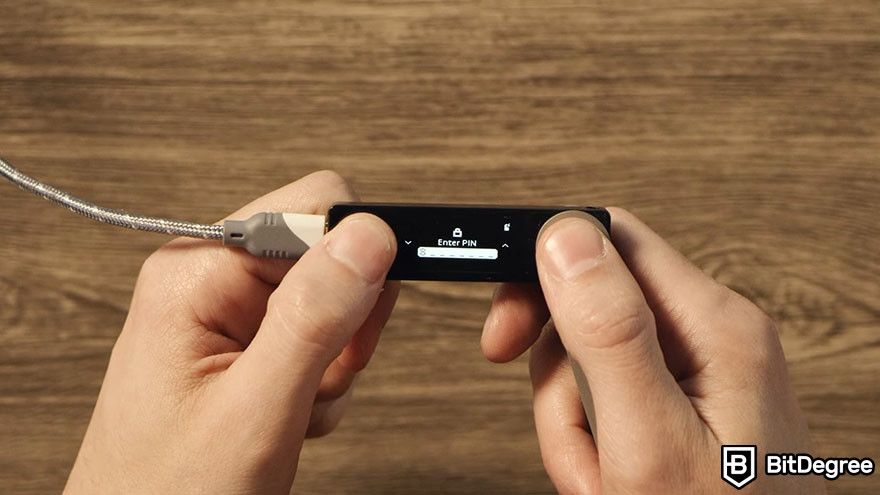
Source: Ledger YouTube channel.
Step 8: Confirm your PIN by entering it again when asked.
Step 9: Get ready to write down your recovery phrase on the recovery sheets that come with the Nano X or any kind of paper. I don’t recommend using apps, screenshots, or password managers to record your recovery phrases.

Source: Ledger YouTube channel.
Step 10: Read the disclaimers on your Nano X, then jot down the 24 words it shows you. Make sure they're spelled correctly and in order.
Step 11: Confirm your recovery phrase on the device by selecting each word.
Step 12: When you’re done, your device will tell you it's ready. Go to the Dashboard.
Step 13: Go back to the Ledger Live app and answer some simple questions to show you understand how to use your Nano X.

Step 14: Do the Genuine Check by clicking “Check my Nano” on the app, then press both buttons on the device when it says “Allow Ledger Manager.”
Step 15: After a successful Genuine Check, you’ll see the main page of the Ledger Live app. This means your Nano X is ready to use.
And there you have it! The step-by-step guide on how to get a crypto wallet from Ledger. Remember that you can always contact Ledger’s customer support if you encounter any issues during your Nano X setup process.

Did you know?
Subscribe - We publish new crypto explainer videos every week!
Remittance Explained: Will This Newcomer Change the Game? (ANIMATED)


Getting a Bitcoin Wallet
Even though there are tons of different cryptocurrencies in the market, some people are true believers and only hold one type of coin; like Bitcoin for example. If you are one of them, you might wonder: ‘Is there a wallet specifically designed for Bitcoin?’ and ‘How do I get a Bitcoin wallet?’
Fortunately, some wallets are made just for Bitcoin, meaning they're built to handle Bitcoin transactions and storage specifically. Ledger Nano X is one of the best Bitcoin wallets in the market that offers a secure way to store your crypto. If prefer a more convenient way to access your Bitcoin, I recommend using Binance Web3 Wallet or Zengo. Both of them are software wallets that you can install on your phone for easier transactions.
So, if you're wondering: 'How do I get a Bitcoin wallet?', it's as simple as choosing between a physical hardware wallet for extra security or a software wallet for convenience, and then following the setup guide to get your Bitcoin journey started.
What is a Crypto Wallet?
Even after you learn how to open a crypto wallet, it never hurts to get a better grasp on the basics. Here are some explanations about the definition of crypto wallets, how they work, and the benefits of using them.
Definition and Purpose of a Crypto Wallet
A crypto wallet, also known as a Web3 wallet these days, is essential for managing and storing your cryptocurrencies safely. But with the rise of Web3, these wallets are becoming more than just a place to keep your digital cash.
They act as your decentralized profile and interact with the blockchain in various ways, like letting you connect to dApps (decentralized applications). These applications are often composed of several services, like transaction scalability protocols, decentralized storage, and distributed computing solutions[1].
So, when thinking about how to get a crypto wallet, you're essentially looking into how to get your hands on the ultimate tool for navigating the new, decentralized web.
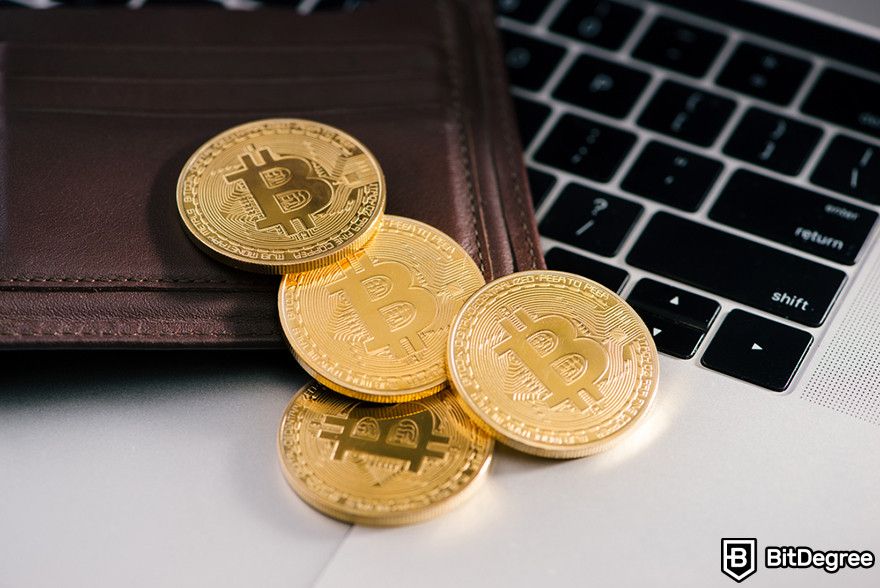
In a crypto wallet, there are two main types of keys: public keys and private keys. Imagine your public key as your home address that you can share with others so they can send you mail (or in this case, cryptocurrency). Your private key, however, is like the secret code you need to enter your private vault. Only you should have it because it allows you to access and control your funds.
When you use your private key, you can sign off on transactions, proving you own the address without revealing your private key. This interaction between the public and private keys ensures that your transactions are secure.
How Crypto Wallets Work
Crypto or Web3 wallets work by tapping into blockchain technology, which is like a digital ledger that keeps a secure and transparent record of all transactions. Imagine a long chain where each link is a transaction or a block of data, and everyone participating in the network can see these links, but they can't alter them once they're added. This structure ensures transparency and tamper resistance[2], as any attempt to alter a block would require changing all previous blocks, making it computationally infeasible.
When thinking about how to create a crypto wallet, you're essentially considering how to get a tool that interacts with the blockchain. Your wallet doesn't actually "store" your digital money in the same way a physical wallet does with cash. Instead, it holds the keys (your public and private keys) that allow you to access your cryptocurrencies on the blockchain.

As mentioned earlier, encryption plays a huge role here. It scrambles your data so that only someone with the right key (in this case, your private key) can unscramble it. This is how your wallet contents stay safe. Without the private key, it would be nearly impossible for anyone else to access your cryptocurrencies.
Understanding these aspects is crucial when exploring how to get a crypto wallet. It’s not just about holding digital currencies; it's about ensuring that your participation in the blockchain is secure and authenticated through your unique keys.
Benefits of Using a Crypto Wallet
Considering the importance of Crypto or Web3 wallets in interacting with blockchain, there are many benefits you can get from using them. Let’s take a look at three of them:
Accessibility
With a Web3 wallet, sending and receiving cryptocurrencies is as simple as sharing a photo online. You just need the receiver's public key to send them crypto, and vice versa. This means you can manage your digital coins from anywhere in the world, anytime, without waiting in line at a bank or dealing with paperwork. It's all at your fingertips, making digital transactions a breeze.
Security
Crypto wallets use advanced security, like encryption, to scramble your data so that only someone with the right key (you) can unscramble it. Even if someone else gets their hands on your wallet, they can't open it without your private key, keeping your digital assets safe from theft and unauthorized access. This high level of security is crucial in the digital world where hackers are always lurking.

Control
Unlike traditional banking or online payment systems where your money is held by someone else, a crypto wallet puts you in charge. You decide when, where, and how to spend or save your digital currencies without asking for permission or paying extra fees. This control is empowering because it removes the middleman, giving you direct management over your digital assets. It's all about having the freedom to manage your money on your terms.
So, learning how to create a crypto wallet is essential if you want to take full advantage of these benefits. It grants you the power to navigate the digital currency space with autonomy, safety, and ease.
Securing Your Crypto Wallet
Like your social media account or email, your crypto wallet needs protection to keep it safe from the bad guys online. Here are three basic security practices to help guard your digital treasure:
- Updating software regularly: Make sure your wallet's software is always the latest version. Developers update software to fix security holes that hackers might use to sneak in. It's like fixing a broken fence so no one can get into your yard.
- Using strong passwords: Pick a tough password for your wallet, something that's hard for others to guess. Use a mix of letters, numbers, and symbols, and avoid easy choices like your name or birthday. Think of it as a strong lock on your door; the harder it is to crack, the safer your stuff inside.
- Two-factor authentication (2FA): This is an extra step of security when you log in. Besides your password, you'll use something else to prove it's really you, like a code sent to your phone.

Advanced Security Measures
In addition to the basic security practices, there are more advanced steps you can take to protect your crypto wallet:
- Multi-signature wallets: These wallets require more than one key to authorize a transaction. This way, if one key is compromised, your assets remain secure because the thief can't complete a transaction without the other keys.
- Using a dedicated hardware wallet: For storing large amounts of cryptocurrency, a dedicated hardware wallet like Ledger Nano X offers extra security. It's a physical device that stores your private keys offline.
- Combining hot and cold wallets: Use both types of wallets for different purposes. Keep a small amount of cryptocurrency in a hot wallet for daily transactions and the bulk of your assets in a cold wallet for long-term storage. This strategy is like not carrying all your cash in your pocket but leaving the majority in a bank vault.
- Regular security audits: Periodically check your wallet's security settings and update them as needed. You can use services that specialize in blockchain and cryptocurrency security to evaluate your wallet's safety. They can help identify potential vulnerabilities and recommend improvements to ensure your assets are protected.

- User-friendly design
- Robust security
- Long battery life

- Dual auditable Secure Element chips
- Quantum-resistant protection
- Water and dust resistant

- Transaction Check feature
- Direct dApps connection
- Great middle-ground price
Recovery Strategies
Even with the best security practices, sometimes unexpected things happen, like losing access to your crypto wallet or having it stolen. That’s why having a recovery strategy is always useful. Here's what you can do to protect your digital currencies in such scenarios:
Use Backup and Recovery Phrases
When you set up a crypto wallet, you'll get something called a recovery phrase. It's a long list of words given in a specific order. You can use your recovery phrase to regain access to your wallet from a different device. Write these words down when you get them and keep them somewhere safe but accessible. Don't store it on your computer or phone where hackers could find it if they sneak in.
Change Your Passwords
Immediately change the passwords for any related accounts, especially if you suspect the theft could lead to access to other personal information or accounts. This includes email accounts linked to your crypto wallet and any exchange accounts.
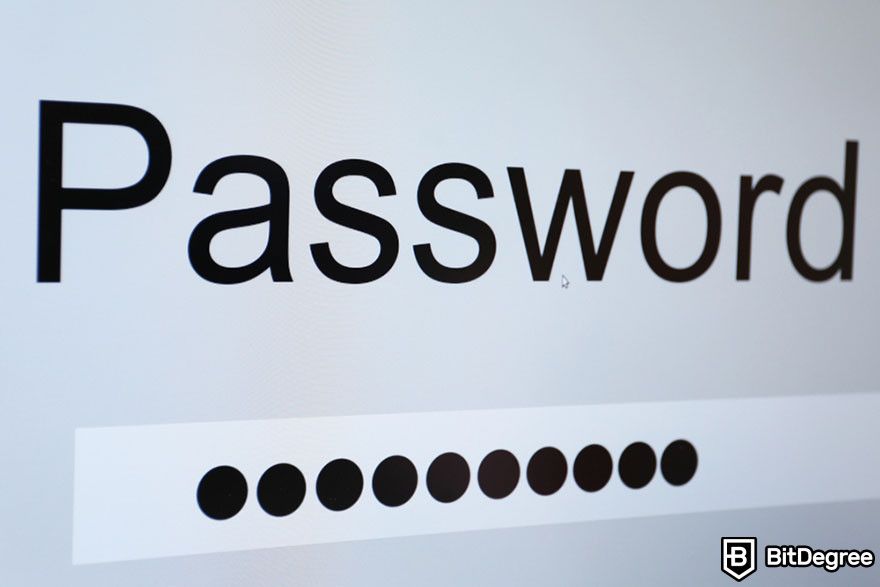
Notify Relevant Parties
If you were using a hosted wallet provided by a crypto exchange or service, inform them about the loss or theft as soon as possible. They may be able to help secure your account or track any unauthorized transactions.
Review Your Security Setup
After addressing the immediate risks, take some time to review how the loss or theft happened. Consider what security measures were bypassed and how you can strengthen your security to prevent future incidents. This might include using more secure wallet types, enabling additional security features, or being more cautious about phishing and scam attempts.
Conclusion
A crypto or Web3 wallet is an essential tool if you want to do most blockchain-related activities like exchanging tokens and accessing dApps. This makes understanding how to open a crypto wallet basically your rite of passage into the blockchain ecosystem.
We’ve learned about hot and cold wallets and what they have to offer in terms of features and security. Combining the best of both worlds is arguably the best approach if you want to be versatile when it comes to interacting with blockchain. I’ve also covered the step-by-step guides on how to open a crypto wallet for Binance Wallet, Coinbase Wallet, and Ledger Nano X to help smoothen your process.
Security is another essential aspect of learning how to get a crypto wallet. Make sure you always apply the core security measures like updating software regularly, using strong passwords and 2FAs on your accounts, and keeping your recovery phrases safe.
Now that you understand crypto wallets better, it is time to start creating one for yourself. If you’re still unsure which provider to choose, I recommend checking out Ledger Nano X, Binance Wallet, Coinbase Wallet, and Zengo for reliable and secure wallet solutions.
The content published on this website is not aimed to give any kind of financial, investment, trading, or any other form of advice. BitDegree.org does not endorse or suggest you to buy, sell or hold any kind of cryptocurrency. Before making financial investment decisions, do consult your financial advisor.
Scientific References
1. L. Besançon, C. F. Da Silva, P. Ghodous: 'A Blockchain Ontology for DApps Development';
2. I. Balodis: 'Blockchain Technology and Its Role in Digitalization'.
